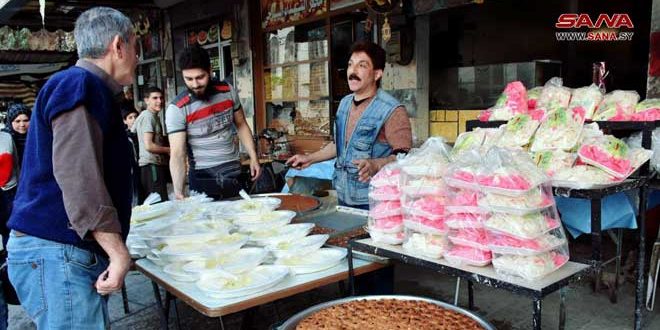The people of Hama keep up the tradition of a special atmosphere and rituals in the holy month of Ramadan, which have not changed until today, despite the circumstances. They still adhere to their social and religious customs and traditions.
Social researcher Abdul Karim Hallaq explained that there are habits and customs used to be adopted by the people of Hama in the past, some of which remain until today and some of them are stored by their sons’ memory.
“Its late son Ahmed Naasan al-Ahdab, was the man who would announce the start of Ramadan- and this distinguished Hama from the other cities. He used to climb the castle, with thousands of people behind him, hours before Ramadan began, to see the crescent of Ramadan,” stating that Al-Ahdab has remained for over 40 years a reference point that proves the sighting of the crescents of Ramadan and Shawwal.
Researcher Hallaq stated that Ramadan rites begin with invitations and feasting between the people. Each family is committed to inviting the girl, the son-in-law, and the aunt to their home, pointing out that the Hama Ramadan banquet is characterized by types of fatty food, such as Sakhtoura, al-Batrash al-Hamwi, assorted kebabs, dough stuffed with meat, and camel meat kofta. They are also keen to prepare various types of juices such as licorice, khashaf, Shami berries, roses, oranges, and lemons.
Among the habits that Hama’s families have maintained, according to Hallaq, is that their evening gatherings begin after the Taraweeh prayer. There are those who love poetry, singing, or playing dice, pointing out that the “Masaharatiyya” are spread in Hama, like the rest of the Syrian cities, roaming the streets, neighborhoods and lanes, beating drums and chanting popular phrases, the most famous of which is (Ya naiem Wahid Al Daiem) to wake up the sleepers to eat the Suhoor meal.
Umm Abdullah says that Ramadan has a special character and that its days are the most beautiful. “In Ramadan people devote themselves to prepare sweets, decorate and beautify them as they excel in making various types of Halawat el-jibn, Hetalia and Warbat,” pointing out that with the approach of Eid al-Fitr in the last ten days of the month of Ramadan, the city’s markets are crowded with people to buy Eid needs of clothes and sweets.
Amal Farhat

